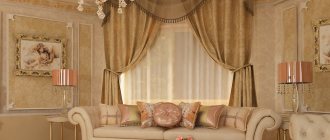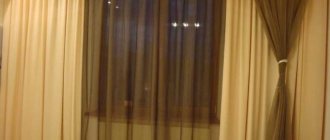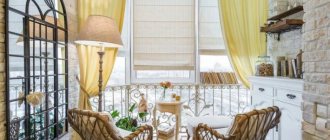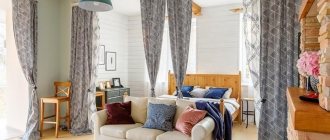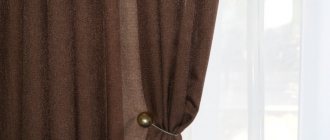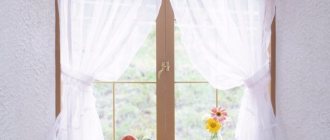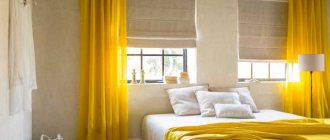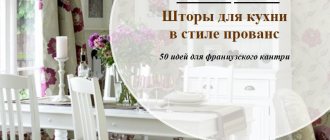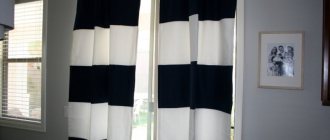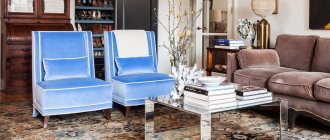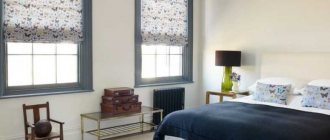Velvet and its varieties
Velvet, like silk, was learned to be made in Ancient China, and in Europe they became familiar with it closer to the 13th century. The material is made by weaving two independent thread warps; the fiber that forms the pile passes between these warps.
The usual fabric with a pile on the front side is formed after cutting the bases.
Initially, velvet fabric was made exclusively from natural silk. Silk threads provide special softness to the fabric, its pile is short, thick and pleasant to the touch, and silk velvet is still the most expensive material.
Later, more affordable varieties of fabric were invented, in which cotton or linen, and later synthetic fiber, became the raw material for the base.
These fabrics have a decorative appearance due to the preserved method of weaving threads, and their characteristics and practical qualities are determined by the type of raw materials used.
The following types of velvet are used for sewing curtains:
- Velveteen. The material is most often made of cotton. It is easily recognized by its specific pile, which forms a ribbed pattern on the front side. Thanks to its vertical pattern, corduroy can improve the proportions of a small room, visually raising the ceiling.
- Velours. The basis of the material is cotton fiber (cut velor) or synthetic knitwear (loop velor). Velor appears thinner than velvet due to its thinner backing, although its pile is slightly longer. Depending on the laying of the pile, smooth, shaped, and embossed types of fabric are distinguished.
- Velvet devore. Textured material with a transparent or translucent base and an exquisite velvet pattern obtained using chemical etching. Modern fabrics include natural (silk, cotton, linen) and synthetic fibers (viscose, polyester).
The voluminous ornament makes velvet devoré a frequent choice when sewing curtains and tulle.
- Panne. A type of pile material on a cotton or silk basis. A three-dimensional design (usually a plant pattern) on the front surface is obtained by pressing at high temperature. Panvelvet is thinner than velvet, the pile height does not exceed 2 mm.
Materials
A variety of fabrics are used for beautiful curtains with velvet. The more famous of them are:
Velveteen. This is an excellent ribbed fabric with which you can achieve the correct geometry of the room;
Velours. Such matter is characterized by increased density, rough surface and amazing strength;
- How to choose a ceiling cornice for curtains: types and design features
Curtains for the bedroom - 135 photos of the best new products and exclusive designs. Review of unusual design options and combinations of curtains in the bedroom interior
Curtains for suspended ceilings - features of design and selection of curtains for interiors (135 photos)
Panne. Another popular type of fabric, known for its charming shine and slightly voluminous pattern;
Velvet devore. This material has a transparent base and a pattern of fibers.
Types of velvet curtains
There are two main types.
Curtains
Gracefully iridescent products will become a striking element of the entire interior. Blackout velvet curtains, simple in style, will add luxury and elegance to the room.
Roman curtains
Uniform velvet folds located on Roman blinds look elegant. However, due to the frequent movement of the structure, such products will wear out very quickly and lose their original appearance.
Italian curtains
These models differ from curtains in that they do not move along the cornice base. Such products are in a fixed state, so it will not be possible to change the level of illumination in the room with them.
"Bishop's Sleeve"
Such interesting compositions complement doorways, as well as various niches.
What should the environment be like?
When choosing curtains for a room made of velvet, it is important to choose the right environment for them:
- Room. The dimensions of the room should be large enough; complex indoor structures - arches, columns, balconies, podiums - are excellent.
- Ceilings. They must be tall; the stucco elements look beautiful.
- Walls. Wallpaper should be discreet, classic, without pretentious decor. The walls can be decorated with paintings in gilded frames.
- Floor. The most suitable covering option is natural parquet with expensive carpets.
- Furniture. Antiques will look ideal. It is desirable that the covering of armchairs, sofas and chairs be leather, plush, or velor.
By observing such design requirements, the interior will be as harmonious as possible, and your stay in the room will be comfortable and enjoyable.
Pros and features of velvet curtains
Velvet is a thick, soft fabric with a high, pleasant-to-touch pile that has adorned the chambers of royals and nobles for centuries. Today there are many varieties of it - velor, corduroy, chenille, plush and others, but they all differ in common features - durability and rich appearance.
To create a luxurious composition of velvet fabrics, you don’t even need additional decor; you just need to choose the right tulle.
Velvet curtains have a number of advantages:
- ·High density, thanks to which curtains can last for years and even tens of years.
- ·Excellent protection from light, cold and extraneous sounds.
- · Resistance to sunlight - velvet curtains do not fade.
- ·Beautiful heavy drapery that gives a special chic to the room.
- ·Wide range, allowing you to choose the type of velvet fabric to suit every taste and budget.
Curtains made of soft fleecy fabric are versatile; they look elegant both solo and as part of lush ensembles. Decorated with a lambrequin, tiebacks or cords, in combination with elegant tulle, velvet curtains give the room a solemn look.
When choosing a luxurious fabric for window decoration, you need to take into account its operational features: velvet requires constant care, since it easily collects dust, but does not really “like” frequent washing. After hanging such curtains, be prepared to periodically clean them with a vacuum cleaner or soft brush.
Bedroom textiles
Curtains, pillows and blankets can be designed in the same color scheme, differ in color or have a completely different color, while echoing the same notes in the design.
Green curtains have a huge number of colors that influence the integrity of the overall picture of the bedroom. The cut, tailoring and color will ultimately create a complete finished piece of furniture.
Tulle for velvet curtains
Heavy, but soft and flexible material needs a carefully selected “companion”, paired with which it will not weigh down or clutter the window area.
Velvet provides ideal combinations with light, plain tulle - matte, glossy or lace.
Another good solution is striped tulle, the color of which can be gold, silver, or in harmony with the tone of the velvet curtains.
Are there any other interesting combinations with velvet? Undoubtedly. Heavy curtains are given an aesthetic and stylish appearance by tiebacks, solemnity by lambrequins, and practicality by light lifting roller blinds instead of classic tulle.
Popular colors
The choice of color is determined by the color palette and interior style; Preference is given to the following colors:
- Shades of brown. The palette includes all colors, from beige, sand and nut, to caramel and chocolate. Brown curtains look not only elegant, but also harmonious and create a cozy atmosphere.
- Pastel. They refresh the interior, giving it a touch of discreet elegance. Fits perfectly into a white or beige interior. Cool colors are suitable for spacious rooms: turquoise, ultramarine, mint, lilac.
For little ones, it is more appropriate to use warm pastel colors: carrot, pale pink, peach.
- Shades of green. Low-key options are popular: olive, pine, dark green. Blue-green, jade, and sea green became popular during the Art Deco era; today they are often chosen for boudoir-style rooms.
- Shades of gray and blue. A favorite choice for modern styles, fabrics come in a variety of rich colors.
- Shades of red. They are rarely used in private interiors because they attract too much attention. An interior with red curtains will be harmonious in a large room furnished with classic furniture.
Shades of green
Today, green curtains are rarely found in the interior of a bedroom or living room, but this color is very multifaceted. Most of them are defined by analogy with the color of plants, natural elements or other phenomena.
Some definitions are familiar to children in Japan, but in African countries the same tone has a different name. For example, the tone of green peas in Vietnam is known as the “color of bamboo shoots,” and the Scandinavians call it “the shade of growing spruce cones.”
In Slavic culture, medical green is considered the most unacceptable color for interior design. Psychologists do not recommend the combination of gray-green curtains - the combination evokes a depressive state.
For interior design, positive shades of this multifaceted color are used. In our culture, they are conventionally divided into fruit, precious and plant palettes.
Precious ones are emerald and malachite shades. The "edible" category includes:
- olive;
- pistachio;
- light green;
- lime.
All of them are suitable for kitchen curtains and curtains for a children's bedroom.
Herbaceous - cumin, anise, mint shade. They fit perfectly into the interior of a country house or cottage. In a modern one-room apartment, curtains in the shade of jewelry stones - emerald, turquoise, aquamarine or malachite - are appropriate.
Rooms
Velvet canvases look elegant and solemn, and give the room an original and unique look.
Living room or hall
Such curtains will look especially great in spacious living rooms. Bright and light shades will add festiveness to the atmosphere of the room, and curtains in darker colors will elegantly emphasize its status.
Bedroom
Velvet curtains with their softness will create a romantic atmosphere in the room. Curtains on one side of the window will ensure maximum light entering the bedroom.
Kitchen
A spacious kitchen with high ceilings and large windows is suitable for decorating with such curtains. Velvet tends to absorb odors, so the room must have a very good ventilation system.
Children's
Velvet curtains are not recommended for use in a children's room, as these products accumulate a lot of dust. However, the choice of decor for a child’s room always remains up to the taste preferences of the home owner.
On the doors
Velor, corduroy or crushed velvet curtains on the doorway will perfectly complement the interior and become a spectacular highlight. With the help of such a curtain composition, you can create both a strict and soft and relaxing atmosphere in the room.
Where is the best place to hang it?
For a small room, curtains made of velvet fabric are not the best option. Since the curtains themselves look quite voluminous, they will visually make the room smaller. Lush curtains made of iridescent velvet fabric are more suitable for spacious living rooms and bedrooms. It is not recommended to use curtains made of velvet materials for a children's room, as they accumulate a lot of dust in a short period of time.
In addition to living rooms, velvet curtains are used in various areas. For example, concert halls are often decorated with formal curtains made of heavy material. When the curtain opens before the start of the performance, its lower part drags beautifully along the floor, creating an exciting mood in anticipation of the holiday. There are also wide, bright recreation areas of universities, cultural centers, conservatories, etc. chic velvet curtains invariably decorate with their appearance.
Care
Velvet curtains can last a long time if you take care of them following the rules. The ideal option for caring for curtains is dry cleaning, but you can’t always entrust your favorite things to strangers. But even home care will not be difficult.
You can wash velvet curtains by hand or in a machine - automatic, the temperature should not exceed 30 degrees.
Fabrics with pile do not like intensive spinning and twisting; with such treatment, delicate fibers can fall out and the curtains will look shabby. Immediately after washing, fold the curtains into a thick terry towel and gently wring them out by hand.
You need to dry velvet curtains laid out on a horizontal surface so that they do not become deformed.
Washing voluminous curtains is a labor-intensive task, so not every housewife dares to carry out this procedure every week. Therefore, we will delight you with a way to weekly care for luxurious velvet curtains. It's simple: use a dry or damp brush to comb the curtains along their entire length, from top to bottom. The situation is the same with lambrequins and other decorations.
Curtain designs in various styles
Velvet curtains will certainly become the main element in rooms of different styles.
Modern
For a modern style, plain velvet curtains are suitable, without unnecessary decorations and decorative elements. Curtains in dark colors will add pragmatism and rigor to the interior.
Oriental
Velvet curtains are simply created for oriental style. The use of thick, draped fabrics in bright and rich colors is especially appropriate here.
Classic
Long velvet curtains that lie on the floor, decorated with tiebacks, fringe, bugles, mother-of-pearl, pom-poms, lambrequins or tassels, are perfect for this style.
Such a curtain composition will fit especially well into the interior.
Photo gallery
PreviousCurtains Review of curtains for the bedroom: new items in modern style, photos in the interior
Next
CurtainsDescription of manual installer of eyelets and buttons
Curtain decor
Able to give curtains an original, thoughtful and finished look.
- With embroidery. Velvet fabrics with embroidery will give the interior a special personality. Curtains embroidered with designs and patterns, monograms or elegant lace look impressive.
- On the eyelets. Curtains made of velvet look majestic and elegant, and this mounting option, such as eyelets, gives them versatility and rigor.
- With tassels. A decorative element such as a brush is used to add solemnity and showiness to curtains.
- With fringe. Fringe will add incomparable charm to the design of a curtain ensemble.
- With rhinestones. With the help of sparkling rhinestones, you can further focus attention on the curtains and emphasize the sophistication of the velvet fabric.
- With edgings. Canvases decorated with neat edging look especially sophisticated.
- Combined. To combine with velvet, satin is best suited. Contrasting double textures in combination look very impressive.
What is better to combine with?
Curtains made of velvet fabric are perfectly combined with various decorative elements.
Tulle
Velvet curtains go perfectly with lace and glossy or matte plain tulle.
Lambrequin
A classic option for decorating velvet curtains. The combination with a soft or hard bandeau lambrequin will add luxury, sophistication and status to the atmosphere.
Tiebacks
Properly selected tiebacks in combination with curtains will add royal chic to the window opening and the decor as a whole.
General information about curtains
- A curtain is a canvas made of dense fabric, on which there is a pattern or embroidery in combination with drapery. Initially, they were decorations for doorways, and they protected the room from drafts.
- The curtain is an integral part of curtains made in classic and modern styles.
- Curtains can perform not only a decorative function, they perfectly protect owners from the sun and prying eyes
Over time, people realized that due to the characteristics of the fabric used, they can also protect from bright sunlight, as well as from extraneous noise. It is thanks to these properties that curtains are so popular today.
The main functions are:
- regulation of light flux;
- preventing rooms from being viewed from the street;
- giving the window opening beauty and expressiveness.
If to perform the first two functions it is enough to choose thick fabric for curtains, then to perform the decorative function it is recommended to listen to the recommendations of designers.
They differ not only in color, but also in material, and it is recommended to choose natural fabrics. Otherwise, you need to be guided by the principle of harmony with the overall design of the living room.
How to tie - ways
When choosing a tying method, it is worth remembering that it should be not only functional, but also aesthetically pleasing. A similar rule applies when choosing the garter itself - it should be in harmony with the style of the interior and the texture of the fabric of the curtains.
For natural fabrics it is better to choose garters in the form of ribbons, for velvet - cords with tassels. In addition, you can use special clamps and pins.
The method of tying depends on the number of panels, the fabric, and the relative position of the windows:
One canvas. If there is only one curtain, then it needs to be tied with a bandage in the middle. It could be a knot or a pattern of them. The choice of accessory depends on the fabric used for the curtains: for a calm curtain, bright decorations are needed, and for a patterned one, they need to be in the same color as the tones used.
For one curtain, it is enough to use a garter, a pin located exactly in the middle
Two canvases. There are several garter options:
- symmetrical - the ties on each individual canvas must be placed strictly at the same height;
- asymmetrical - the tiebacks are located at different heights, one of which is at the level of the window sill;
- corner - the edges of the curtains are fixed to the walls adjacent to them, due to which the window partially opens;
Curtains can be attached both to the adjacent wall and to the opposite one
- crosswise - two canvases are attached in a similar way to the previous one, but only to opposite walls.
- Two windows. The situation when two windows are located a short distance from each other is not so rare. You can add aesthetics if you tie the two outer panels with appropriate ties, and simply tie the two adjacent ones with a knot.
